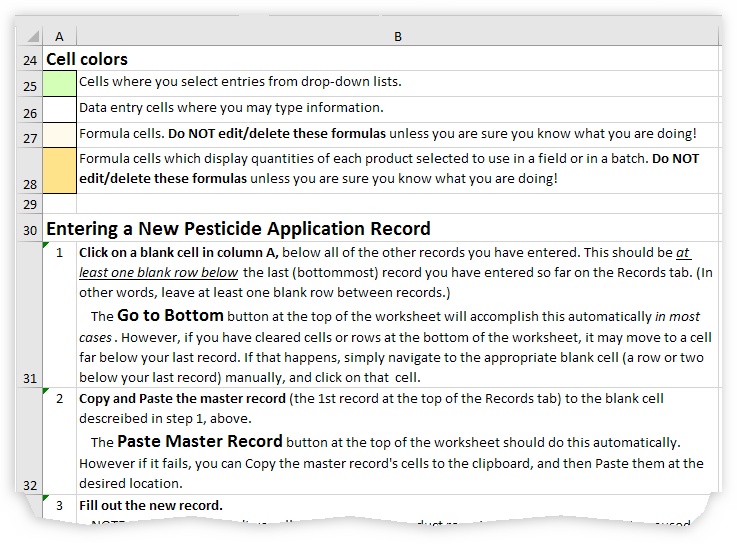
|
*** Free Downloads! *** |
Jump to... Prev Top Next More |
Excel workbook for batch calculations (and pesticide application records)
This free Excel workbook is a simple way to calculate quantities of almost any kinds of things you'd mix together as a batch. It was designed to calculate and keep records of products used in herbicide batches (and optionally, government-mandated pesticide application records) without a lot of typing or writing records by hand. Worksheet macros automate creation of new records (we call them batch tickets). And selecting from drop-down lists lets you add records with very little typing.
If you are willing to enter prices for the pesticides you use, this workbook can also help with herbicide program cost comparisons, input purchase planning, and more.
Free to use, copy, and/or modify...enjoy!
Click the arrow to Download: |
Excel Batch Mix Tickets (and Pesticide Application Records) Workbook Filename: BatchMixTickets_ver3.xlsm Operating systems: Microsoft Windows 7 and later; Windows 2003 Server and later; or Android or iOS (Apple) System requirements: Microsoft Excel (for Windows, Android, or iOS), or LibreOffice Calc. Works on PCs, tablets, and smartphones. |
Here is an example of a single ticket for a batch of burndown herbicide for a 20-acre field. The workbook file can hold as many tickets as you want, and you can print out any or all of them at any time. (Typically you might print out a ticket to take to where you mix the batch--or you might take the workbook with you, running on an Android, Apple, or Windows tablet.) The important thing to note, is that the yellow cells show the product quantities to use in mixing the batch, displayed in whatever units you want (gallons, quarts, pints, ounces, pounds, etc.):
The light green cells of a batch ticket are filled by selecting from drop-down lists. Those lists are populated from the setup information/data that you enter on the workbook's Data tab:
Once entered, this data is available for selecting in every batch ticket you enter.
Here's an example of two batches mixed to complete spraying of one field. They have been labeled as "Batch #1" and "Batch #2", and "of 39" has been added on the acres line to show that each batch was for only part of the total acreage sprayed.
Note that this workbook is useful for calculating quantities for any kind of batch or quantity. This example shows that it can be used for calculating the number of units of either corn or soybean seed needed for an 83 acre field, planted at specific populations:
Using the workbook is simpler than it might appear just from viewing these few screen shot images, and another worksheet tab contains a full set of instructions for setting up data, adding new/blank batch tickets, filling in batch tickets, and so on:







